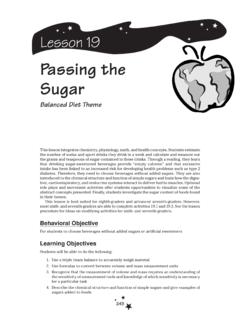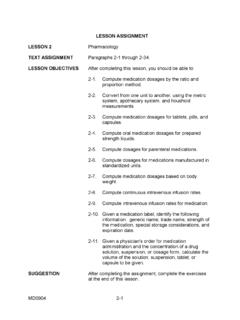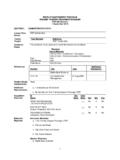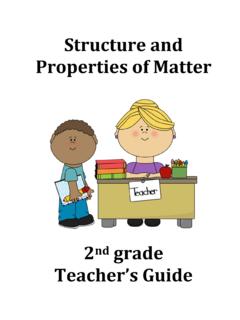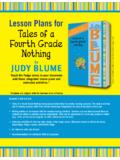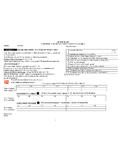Transcription of Lesson 3 - Planet Health
1 71 Lesson 3 Food PowerBalanced Diet ThemeIn this Lesson students read an article on nutrition and apply the information contained in the article to categorize foods and plan menus. Through these activities they will be introduced to the concept of macronutrients (protein, carbohydrate, and fat) and micro-nutrients (vitamins and minerals) and learn how to choose foods from the five main food groups (grains, vegetables, fruits, dairy, and meat and beans group) that will provide them with a healthy balance of the nutrients they need. Finally, they will have the opportunity to write an opinion about whether their diets would be classified as a healthy eating plan.
2 Then, using the information provided in the nutrition article, they will be able to defend their ObjectiveFor students to eat a balanced and varied diet based on the five food groupsLearning ObjectivesStudents will be able to do the following: 1. Read and understand informative and nonfictional text 2. Create a concept map using nutrition terms and vocabulary 3. Write clearly and persuasively 4. Categorize foods into the appropriate food groups, and use the information gathered to plan a varied and healthy snack menuMaterials Overhead transparency , A Balanced Plate for Health Student resource , What s With These Nutrients? Student resource , What s in a Group? Activity Food Power: All You Need to Know for Health (informational reading) Activity , Nutrition Concepts and Vocabulary (worksheet and concept map) Lesson 3 Food Power72 Activity , Food Group Categories and Situational Analysis Activity , Self-Reflection (can be given as homework)ProcedureActivity : infOrMAtiOnAL reAding And AssessMentActivity gives students the opportunity to discuss what they know about nutrition and healthy eating.
3 They read an article that gives them an accurate description of what it means to eat healthfully and why they should pay attention to what they eat. 1. Begin the Lesson by asking students to describe what healthy eating means to them and to list some things that they have heard about nutrition. 2. Explain how nutrition is an evolving science, and that the Dietary Guidelines and other nutrition recommendations are updated every few years to make certain that we take into account the latest science as we plan healthy meals and snacks. 3. Distribute the informational reading (activity ) that outlines the Planet Health guidelines for healthy eating. You may want to read the material aloud as a group if your students are younger (sixth grade), taking time to explain key words and key concepts.
4 Use overhead transparency , A Balanced Plate for Health to review the kinds of foods in each food group. Note that sometimes foods are on a separate side plate. 4. Discuss the reading by asking students to respond to the following questions: What are the key components of a healthy eating plan? (See Specific Background Material under Teacher Resources for a description of the Planet Health guidelines for healthy eating.) What are the two main categories of nutrients (macro- and micronutrients), and what makes them different from each other? (Answer: Macronutrients provide energy; micronutrients include vitamins and minerals, which do not provide energy.) Name some examples of macronutrients and micronutrients.
5 What does it mean to eat a balanced diet? (This can refer to the balance of food groups and to the balance between energy consumed and energy expended in activity.) How can you make sure you get enough of all the nutrients in your diet? (Answer: Eat foods from all food groups plus different foods within each group.)Activity : nutritiOn cOncePts And vOcABuLAryIn this activity, students help you complete a concept map (part I) and also complete a worksheet (part II) that uses verbs to reinforce some of the nutrition concepts presented in the reading. The concept map will be most successful if your students are familiar with concept mapping or webbing. If they are not, you should precede the activity with the fol-lowing explanation.
6 1. Explain the following:Why should we do concept maps? They are important study tools that help you store information in your long-term memory. They help you figure out the main ideas in a piece of reading material. They help you organize new material and establish relationships among 3 Food PowerHow do you make a concept map? What are the rules? A feature of concept maps is that main ideas are placed at the top of the map. Smaller, more specific concepts and examples go below the main ideas. Concept words go in the circles or boxes. These are labels for ideas or concepts. All of these words are concepts because they cause a picture to form in your mind (examples: car, dog, thinking, bread, carbohydrate).
7 Concepts should never contain more than three words. Linkage words connect, or link, concept words. They go on a line connecting the circles or boxes (examples: are, the, when, is, to). Concepts should not be repeated. Instead, extend the linkage line to where that concept first appeared. 2. Display the overhead transparency of the concept map that illustrates the breakdown of nutrients in foods (activity , part I). Ask students to choose concepts listed in the word bank to complete the concept map. Do this as a class activity or have students work in groups. (The answer key follows the teacher resources.) 3. Distribute activity , part II, and instruct the students to write a paragraph using four of the eight words in the word bank to explain a key aspect of healthy eating.
8 You may want to assign this writing task as homework. Alternatively, you may choose to do this activity verbally as a class, calling on individual students to use the words in a sentence about healthy : fOOd grOuP cAtegOries And situAtiOnAL AnALysisIn this activity students work in groups to categorize foods into a table that identifies each food by its food group and whether the food fits into an everyday healthy eating plan or is a sometimes food. They then use this information to create a weekly snack plan. 1. Divide the class into groups and distribute activity , Food Group Categories and Situational Analysis. Each group should receive just one activity worksheet to pro-mote teamwork.
9 Part I (categorization): Instruct the group to work together to determine in which food group each food or beverage belongs. The other group should be used for foods that have a lot of unhealthy fat or sugar, and therefore should be consumed only sometimes meaning not every day. Share the answers prior to working on part II. Part II (situational analysis): Instruct the groups to review the situation and, using the foods listed in part I as a guide, plan three snacks for their after-school club that offer healthy choices and variety. Remind the groups that each snack should include three food groups, and that over the three days, foods should not be repeated. Be sure to include time for students to discuss their responses and review where they can go to get current and accurate nutrition : seLf-refLectiOnActivity may be used as a homework assignment to save on class time.
10 Students con-sider the information learned in the nonfiction reading to write a short essay that explains whether they are eating students to use specific details from the informational reading (activity ) along with the student resources and to support their opinions. They should respond to the following questions: Lesson 3 Food Power74 Are you eating a balanced diet? Why or why not? Are you eating the same foods each day? In which group do you get the most variety? In which group is it hardest to get variety? What could you try to add variety to your diet? List one to three things that you can do to improve your diet. List one to three things that you are doing well to eat healthfully.
